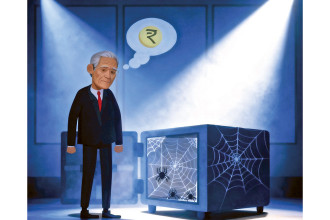
E-commerce in Nepal is witnessing a remarkable transformation. Wider access and adoption of the internet, accessibility and affordability of smartphones, rising disposable income, technological innovations, and the adoption of digital payment systems have played a pivotal role in how consumers shop. Moving ahead, AI advancements, social commerce, advanced data analytics, flexible payment options, evolving fintech and greater focus on sustainability will shape the future of e-commerce in the country as it does the rest of the world.
To understand how the e-commerce sector is evolving in the country and what lies ahead, in this edition of Business 360, we spoke to some leading e-commerce executives.
How has technology transformed the e-commerce landscape in Nepal? What are some emerging trends you anticipate in the near future?
Manohar Adhikari: Technology is revolutionising e-commerce in Nepal, primarily through the growing use of smartphones, improved internet accessibility, and the adoption of digital payment systems. Looking ahead, I anticipate growth in quick commerce, more personalised shopping experiences, and a greater focus on sustainability within e-commerce platforms.
Ashit Mahato: When we launched Dealayo, we were one of the few e-commerce platforms in Nepal. Back then, the concept of buying online was still very new to most people. Technology has truly been the driving force behind how far e-commerce has come, especially in the last few years.
One pivotal moment was the Covid 19 lockdown. The lockdown period accelerated digital adoption like nothing we could have imagined. With physical stores closed, people who had never shopped online before were suddenly forced to turn to platforms like ours for their essential goods. It was a tough time for everyone, but from a technology perspective, it pushed both businesses and consumers to adapt quickly. We saw an increase in demand and had to upgrade our systems and logistics almost overnight.
Mobile internet penetration has also been key. With more affordable data plans and smartphones becoming accessible to a broader audience, people across the country, from Kathmandu to rural areas, are now able to shop online. Today, the majority of our users access Dealayo through their mobile devices.
Emerging Trends
AI and Personalisation: We have started using AI to offer customers personalised shopping experiences – recommending products based on their past behaviour. In the future, AI will play an even bigger role in helping us understand what customers want, even before they know it themselves.
Sustainability: Consumers, especially younger ones, are becoming more eco-conscious. We’re looking at more sustainable packaging solutions and delivery methods to meet these expectations.
Rural E-commerce Growth: As internet access continues to improve in rural areas, we expect to see a surge in e-commerce demand outside the major cities. That’s an exciting frontier for us.

Manohar Adhikari
Founder & Managing Director
Foodmandu
Subin Man Pradhan: The rapid advancement of technology has brought significant changes to the e-commerce landscape in Nepal, leading to increased accessibility, convenience and overall efficiency. The widespread adoption of mobile-first platforms has enabled people to shop anytime and anywhere. Additionally, the growing acceptance of digital payments is gradually reducing reliance on cash transactions. The evolution of the e-commerce landscape in Nepal can be attributed to several key factors. Firstly, increased internet accessibility has expanded infrastructure and mobile connectivity, allowing a broader audience in both urban and rural areas to engage with online shopping platforms. Additionally, the prevalence of smartphones has fuelled mobile commerce, prompting businesses to optimise their platforms for mobile use.
The rise of digital payment systems, such as e-wallets Fonepay, and mobile banking, has further facilitated easier and more secure transactions, with services like eSewa and Khalti becoming increasingly popular for online purchases. Social media platforms, particularly Facebook and Instagram, play a significant role in marketing and sales, enabling businesses to reach customers through targeted ads and influencer partnerships. SmartDoko has emerged catering to specific local needs and preferences while supporting both business-to-business (B2B) and business-to-consumer (B2C) transactions. Together, these factors are reshaping the e-commerce environment in Nepal, making it more accessible and dynamic.
At SmartDoko, we have focused on improving our logistics and integrating a recommendation engine that personalises the shopping experience by suggesting relevant products based on user behaviour. Looking ahead, I anticipate further developments in AI-driven shopping experiences and chatbots, which will offer more personalised interactions and enhance customer satisfaction.
Emerging trends in the e-commerce landscape are reshaping how businesses engage with consumers. Personalisation is becoming a key focus, driven by advancements in data analytics that tailor shopping experiences to individual user behaviours and preferences. Simultaneously, there is a growing consumer interest in sustainability, prompting e-commerce platforms to adopt eco-friendly practices and offer transparent supply chains. The integration of artificial intelligence and chatbots is enhancing customer service by providing instant responses and personalised recommendations, improving overall satisfaction. Moreover, businesses are increasingly embracing omnichannel strategies, blending online and offline sales to create a seamless customer experience. Innovations in logistics are addressing last-mile delivery challenges, especially in remote areas, thereby boosting operational efficiency. Lastly, the growth of niche markets, which cater to specific interests like handmade goods and organic products, is attracting targeted consumer bases and further diversifying the e-commerce landscape.
In conclusion, as technology continues to evolve, e-commerce in Nepal is poised for significant growth and diversification. Businesses that adapt to these changes and trends are likely to thrive in this dynamic landscape.
Sitaram Rimal: Technology has significantly transformed the e-commerce landscape in Nepal, with mobile penetration, digital payment solutions, social media integration, logistics and delivery services, online marketplaces, and customer engagement becoming key trends. Mobile commerce has become popular due to smartphone usage, while digital wallets and mobile banking have made online transactions more convenient and secure. Social media platforms like Facebook, Instagram and TikTok have become vital for marketing and selling products. Improved logistics infrastructure has streamlined supply chains, and local online marketplaces like Meroshopping has provided a broader audience. Data analytics is being used to understand consumer behaviour, allowing businesses to improve marketing strategies.
Emerging trends include increased focus on sustainability, augmented reality and virtual reality, AI and chatbots, cross-border e-commerce, subscription services, regulatory developments, and local content and language. As the market matures, businesses that adapt to these trends will be well-positioned for success.

Collaboration with the government to enhance policies and strengthen consumer protection laws is crucial for long-term growth. Policy gaps are a significant barrier to building consumer trust and once strong regulations are in place, only serious players will thrive.
Surakchya Adhikari
Co-founder & COO, Thulo.com
Surakchya Adhikari: Technology has transformed Nepal’s e-commerce landscape over the past decade, with the impact becoming more evident during the Covid 19 lockdown. The rise in internet access, has driven more people to shop online, with over 50% of the population connected by 2024. Mobile apps have become a popular shopping method, while e-wallets, QR payments, and bank integration have made transactions smoother and more trusted. Enhanced logistics networks ensure efficient delivery, even in difficult areas. Local marketplaces and social media platforms have empowered small businesses, while AI and automation improve personalisation, inventory and supply chain management.
Emerging trends in Nepal’s e-commerce include a growing shift towards digital payments as wallets and online banking become more secure, moving the country closer to a cashless economy. Omni-channel retailing is blending online and offline experiences for better customer engagement. AI and chatbots are enhancing customer service and personalisation, while rural e-commerce is expanding as internet access improves. Sustainability is gaining attention with a focus on eco-friendly practices, and blockchain may enhance transparency in transactions. Additionally, voice search and shopping could become popular as smart devices grow in use.
Aanchal Kunwar: We have seen a growing trend of e-commerce adoption among Nepali consumers over the past couple of years, thanks to the increase of internet penetration. The internet penetration rate jumped to 51.6% in 2023, while it was only 29% in 2018 [source: World Bank Nepal]. Currently, we see orders coming in from both inside and outside Kathmandu Valley, with 54% from the valley and 46% outside. A large chunk of orders placed come from youth aged 18-24, however, we have noted a lot of youth placing orders on behalf of their parents and grandparents, so we can confidently say Daraz serves all age groups. We have also seen an increase in awareness and willingness from people to shop online over the years. Penetration in categories like Mother & Baby, Health & Beauty, Furniture & Decor has increased in the past two years, which shows people’s confidence and trust in shopping online for personal categories beyond Electronics. In the future, we see a growing number of Nepalis from all age groups developing more trust in shopping online and increasing Daraz’s services to rural areas in Nepal.
What are the key infrastructural challenges facing e-commerce in Nepal and how do you navigate them?
Manohar Adhikari: Major challenges in Nepal are the lack of proper urban planning and the absence of a standardised and efficient addressing system. Poor road conditions and traffic congestion are everyday issues that negatively impact the customer experience. To navigate these challenges, we focus on utilising mapping technologies for navigation and providing thorough training to our delivery riders.
Ashit Mahato: Running an e-commerce business in Nepal is challenging, to say the least. Our geography is unique, with difficult terrains and underdeveloped logistics infrastructure, especially when it comes to delivering to rural areas. Getting a package from Kathmandu to remote regions can be slow and unpredictable due to poor road conditions.
So how do we navigate this? We have built strong partnerships with local delivery services to help expand our reach. We also use a hub-and-spoke model for deliveries, which helps optimise routes and cut down on delays. Our investment in logistics technology, like GPS tracking and route optimisation, has allowed us to improve our efficiency but there is still a long way to go, especially as the demand for faster, reliable deliveries grows.
-1730181255.jpg)
Subin Man Pradhan
General Manager, Smart Doko
Another challenge is the payment infrastructure. Although digital payments have grown, many people in Nepal still prefer cash on delivery (COD). This presents a challenge for us because COD is not as efficient but it’s important to meet customers where they are. We are working to promote digital payments by offering incentives like discounts and cashback when people use digital wallets like eSewa or Khalti.
The last piece of the puzzle is government regulation. Import duties are high and customs processes are often slow, making it harder for us to bring in international products. We have adapted by working more with local suppliers, which helps reduce costs and delivery times.
Subin Man Pradhan: Infrastructure challenges are a major obstacle for e-commerce in Nepal. Issues such as limited road access in rural areas, inconsistent internet connections, and slow adoption of digital payments persist. To address these challenges, SmartDoko has implemented a hybrid delivery model, working with major logistics companies and local partners to ensure that customers can be reached regardless of their location. The company is also collaborating with payment gateway providers to streamline online transactions and is focusing on educating customers about the benefits of cashless transactions.
E-commerce in Nepal faces several key infrastructure challenges that can significantly impact its growth and efficiency. One major issue is limited internet connectivity, particularly in rural areas, where access is often slow or unreliable. To address this, businesses can invest in offline capabilities, such as telesales and SMS-based services, that allow users to order required products without needing constant internet access. Another challenge is logistics and delivery, especially in remote regions with difficult terrain. Strategies like partnering with local courier services familiar with these areas, utilising bike or motorcycle delivery, and establishing convenient pick-up points can enhance last-mile delivery. Payment system limitations persist, as cash remains the dominant form of transaction, and not everyone has banking access. Offering diverse payment options – such as cash on delivery, card on delivery, mobile wallets, and bank transfers – can cater to various customer preferences. Additionally, evolving regulatory hurdles create uncertainties; thus, staying updated on local laws and engaging with government bodies can help advocate for supportive policies. Consumer trust and security concerns also hinder growth, making it essential to implement robust security measures, provide clear return policies, and highlight customer testimonials. Lastly, many small businesses lack the technical infrastructure to effectively manage e-commerce platforms. Providing training and resources on e-commerce best practices and digital marketing can empower these businesses, fostering a more robust e-commerce environment in Nepal.
Sitaram Rimal: E-commerce in Nepal faces several infrastructural challenges, including limited internet connectivity in rural areas, a preference for cash-on-delivery, poor logistics and delivery infrastructure, evolving regulatory framework, customer trust and awareness, supply chain issues and technology adoption.
To overcome these challenges, businesses should invest in offline strategies, educate consumers about digital payment options, develop partnerships with local courier services, stay updated on regulatory changes, establish strong brand presence, diversify offerings with multiple suppliers, and offer training and resources for local businesses. By understanding the local context and engaging with communities, Meroshopping is overcoming these infrastructural obstacles to thrive in an increasingly digital landscape.
Surakchya Adhikari: E-commerce in Nepal faces several infrastructural challenges, including limited and unaffordable internet access in rural areas, inadequate logistics and delivery networks, digital illiteracy to a huge extent and underdeveloped payment systems. In many regions, unreliable internet and challenging terrain hinder last-mile delivery, especially in remote areas. Additionally, the continued reliance on cash-on-delivery is driven by a lack of trust in digital payments, and regulatory frameworks for e-commerce remain unclear, complicating operations.
Collaboration with the government to enhance policies and strengthen consumer protection laws is crucial for long-term growth. Policy gaps are a significant barrier to building consumer trust and once strong regulations are in place, only serious players will thrive. To address digital illiteracy among consumers, we regularly offer training and knowledge resources. Additionally, we must improve our operational processes and focus on increasing consumer engagement with our websites and apps.
Aanchal Kunwar: Nepal faces significant infrastructure challenges, including inadequate road networks. For us, expanding to all areas of Nepal has always been a priority but the lack of a proper centralised addressing system (to locate customer addresses) and reliable intercity connectivity has brought us challenges. In addition, unreliable electricity supply and limited internet connectivity in rural areas is also a real challenge.
Despite the inherent geographical challenges and connectivity issues in Nepal, we remain committed to further expanding our services to serve the increasing consumer needs. We are continually exploring new locations based on market insights and are dedicated to fostering partnerships with various third-party logistics companies and local governments to ensure that Nepali consumers, to the greatest extent possible, have access to the products they need.
Customer experience can make or break an organisation. How do you incorporate feedback to enhance user experience?
Manohar Adhikari: Customer feedback is a key factor in improving the customer experience. We actively gather feedback through user reviews and social media engagement. This data is analysed to identify patterns and areas for improvement, after which we make necessary adjustments to our internal service delivery processes, partner coordination and tech enhancements.
Ashit Mahato: At DealAyo, we have always believed that customer experience is the core of our business. In an emerging e-commerce market like Nepal, where people are still getting used to shopping online, trust and a smooth user experience make all the difference. We have learned that customers expect more than just products – they want a reliable, seamless shopping experience, and that’s what we focus on delivering every day.
We take customer feedback very seriously. Our team is constantly listening to our customers through reviews, social media and direct interactions. Every piece of feedback helps us understand where we need to improve and what’s working well. Based on this, we have made a lot of changes. For instance, we have enhanced our search and recommendation systems to make it easier for users to find exactly what they need without wasting time scrolling. Our informed delivery system helps customers save time by showing them relevant products based on their preferences – this way, they can skip the hassle of endless searching and get straight to what they want.
We understand how hectic life can be, especially in cities like Kathmandu where traffic and pollution can make even basic shopping difficult. By simplifying online shopping, we are helping people focus their time on the things that matter most, instead of worrying about prices or product availability. Our commitment to offering the best prices also means customers do not have to spend time bargaining – they can trust DealAyo to give them great value, upfront.
Beyond that, we also ensure that our customer service is always accessible. Whether it is through our support team or online chat, we are here to help resolve any issues quickly. And when customers face problems, we do not just fix them – we learn from them. For example, based on feedback about delivery delays, we optimised our logistics and delivery network, ensuring faster, more reliable service, even to remote areas.
In short, we see every customer interaction as an opportunity to improve and offer a better experience. Our goal is to make shopping on DealAyo not just convenient but also pleasant and trustworthy, so customers come back because they know they will get a hassle-free experience with us.
Subin Man Pradhan: At SmartDoko, we have built a solid feedback loop where we are constantly gathering insights from surveys, reviews and our customer service team. And, not to mention we do occasionally check out competitors’ posts and comments – if we see customers complaining about something, we take notes and figure out how we can improve. But seriously, we are committed to constantly getting better. We even have a dedicated team that focuses on enhancing the customer experience throughout the shopping journey. Sometimes, we offer discounts or coupons to encourage feedback but we are always ready to go the extra mile. Some feedback is easy to handle right away, while others require system-level changes, so we make carefully evaluate the solutions and incorporate it as a new process. Every month, we focus on one major pain point that users are facing and fix it, instead of trying to tackle everything at once.
Incorporating customer feedback to enhance user experience is crucial for any organisation, and several effective strategies can facilitate this process. First, establishing feedback channels is essential; utilising post-purchase surveys and website feedback forms can provide valuable insights, while social media listening helps monitor customer sentiments in real time. Analysing feedback regularly is vital, using both quantitative and qualitative methods to identify common themes and pain points, and segmenting feedback by customer demographics for tailored improvements. Acting on feedback promptly demonstrates responsiveness – prioritising high-impact changes and implementing quick fixes can show customers that their opinions are valued. Closing the feedback loop is equally important; informing customers about changes made in response to their input fosters trust and encourages ongoing dialogue. Creating a customer advisory board invites loyal customers to share ongoing insights, enhancing the sense of partnership. Additionally, utilising A/B testing for new features allows organisations to gauge customer response before a full rollout, refining approaches based on real user behaviour. Leveraging technology, such as CRM tools and AI analytics, streamlines the collection and analysis of feedback, enabling better prediction of customer preferences. Training staff on the significance of customer experience ensures that all team members recognise and effectively respond to customer input. Lastly, treating customer experience as an ongoing process encourages continuous improvement, prompting organisations to regularly revisit feedback to adapt and innovate according to evolving customer needs.
Sitaram Rimal: Feedback is essential for enhancing user experience and building customer relationships. To do this, Meroshopping collects and analyses feedback at various touchpoints, prioritises issues based on frequency and severity, engages with customers, collaborates internally, implements changes, tests and iterates, communicates changes, creates a feedback loop, and measures success using metrics like Net Promoter Score, customer satisfaction, and customer effort score. By actively incorporating feedback, Meroshopping is creating a customer-centric culture that evolves to meet user needs, fostering a more positive user experience.
Surakchya Adhikari: Customer experience is crucial to an organisation’s success. To enhance user experience, we actively gather and analyse feedback through surveys, reviews and direct interactions. This helps us identify pain points, improve product offerings and streamline processes. We also use feedback to personalise services, refine our platforms, and ensure continuous improvement, ensuring a customer-centric approach.
Aanchal Kunwar: Providing Daraz customers with the best possible experience is at the forefront of our operations. For us, the customer experience begins right when a customer decides to download the Daraz app and continues on even after the customer receives their order. At Daraz, we conduct customer surveys on a regular basis to derive Net Promoter Scores (NPS) to analyse 12+ touchpoints, such as return experience, pricing, ordering experience, refund experience and more. This allows us to capture detailed insights at every stage of the customer journey.

From the government side, we have seen tremendous support and attention for e-businesses in recent years and months. An e-commerce bill has been drafted and is in discussion at various government levels for approval at the moment. We have also seen a shift in the government’s understanding of e-commerce and the value it brings to the country’s digital transformation.
Aanchal Kunwar
Managing Director, Daraz Nepal
Additionally, we offer live chat availability from 9am to 6pm for all customers, ensuring round-the-clock support, where customers can provide feedback or raise complaints. Our dedicated teams handle all issues, whether they relate to orders, sellers or the platform. This proactive approach helps us quickly address concerns, adjust processes and continuously improve the overall user experience.
How do you view the government’s role in driving a more conducive environment for the growth of e-commerce in Nepal?
Manohar Adhikari: The government plays a vital role in building an ecosystem that supports the growth of e-commerce. The e-commerce industry has significant potential to create job opportunities, formalise economic activities, and generate revenue for the government. Therefore, recognising the contribution of this industry, reducing regulatory bottlenecks, implementing proper policies and regulations, more practical labour policies, and clear legal provisions on consumer protection and taxation can directly influence the sector’s success.
Ashit Mahato: The government plays a key role in supporting the growth of e-commerce and while we have seen some progress, like expanding internet access to more rural areas, there is still a lot that can be done to really unlock the potential of this industry.
One of the main challenges we face at DealAyo is import regulations. Right now, high import duties and complicated customs processes are real hurdles that make it difficult for us to expand our product range and offer international goods at competitive prices. If the government could streamline these processes – perhaps with more e-commerce-friendly policies – it would open up a lot more opportunities for us and other businesses. Ultimately, it would mean a wider variety of products for customers at lower prices.
Another area where the government could have a significant impact is in encouraging digital payment adoption. While we have seen growth in the use of digital wallets like eSewa and Khalti, Nepal still does not have a fully integrated digital financial system. A lot of customers are still hesitant to adopt digital payments, often due to concerns over high transaction fees or security issues. The government could really help here by offering incentives to both businesses and consumers, whether that’s through lowering transaction fees or providing tax breaks to encourage digital transactions. This would make online shopping much more accessible and convenient for everyone.
Data privacy and security are also huge concerns as more and more people turn to online shopping. Customers need to know that their personal information is secure when they shop online. A clear regulatory framework around data protection would not only safeguard consumer information but also build trust in the e-commerce industry, encouraging more people to shop online without hesitation.
-1730181252.jpg)
Ashit Mahato
CEO, Dealayo
Of course, I am aware that political instability in recent years has made it challenging for consistent policies to be implemented. But if we want to see the e-commerce industry grow and truly thrive, the government needs to take long-term, strategic actions that go beyond short-term fixes. E-commerce has the power to significantly boost Nepal’s economy but it needs a solid regulatory foundation to flourish.
In summary, if the government focuses on making import regulations more e-commerce-friendly, promoting digital payments, and ensuring data security, I believe the future of e-commerce in Nepal will be incredibly bright. These steps will not only benefit businesses like DealAyo but also empower consumers across the country.
Subin Man Pradhan: The growth of e-commerce in Nepal relies on policies that support digital payments, better infrastructure and provide regulatory clarity. While positive steps have been taken to promote digital literacy and support startups, there is still more that can be done to improve logistics and create tax structures that are friendly to e-commerce. The government plays a crucial role in creating an environment conducive to this sector. Government involvement can significantly impact key areas, such as developing a clear regulatory framework for online transactions, ensuring consumer protection and data privacy, and providing tax incentives for startups to encourage growth. Additionally, improving internet connectivity, especially in rural areas, and enhancing logistics support for efficient delivery systems are vital for expanding e-commerce participation. The government should also collaborate with financial institutions to promote secure digital payment systems and boost the adoption of e-wallets and mobile banking. Educating consumers on digital literacy and the benefits of online shopping can increase their trust in e-commerce. Support for small and medium-sized enterprises (SMEs), through incentives and training programmes can further stimulate local business participation. Public-private partnerships can help address challenges related to logistics and technology, while robust data security and privacy regulations will safeguard consumer information. Continuous monitoring and updating of policies will ensure that regulations remain relevant in the evolving digital landscape. By actively engaging in these areas, the government can create a sustainable and thriving e-commerce ecosystem in Nepal, benefiting both consumers and businesses.
Sitaram Rimal: The Nepali government can play a crucial role in promoting e-commerce growth. Key areas include establishing a regulatory framework, investing in digital infrastructure, providing tax incentives, supporting SMEs, promoting digital literacy, partnering with private sector companies, enforcing consumer protection policies, facilitating secure online payment systems, supporting digital payment systems, and promoting cross-border trade. These actions can help build trust in e-commerce, improve access to goods and services, and drive economic growth. The government can also provide training, resources and financial support to SMEs, promote digital literacy and collaborate with private sector companies to foster innovation and improve service delivery. This will ultimately drive economic growth and improve access to goods and services across Nepal.
Surakchya Adhikari: By implementing clear regulations via conducive policies, improving digital infrastructure and ensuring consumer protection, the government can foster trust in online transactions and encourage more businesses to enter the market. Additionally, investments in logistics, internet access in rural areas, and digital literacy initiatives are essential for expanding e-commerce’s reach. A collaborative approach between the government, private sector and consumers is key to driving sustainable growth in the industry.
Aanchal Kunwar: From the government side, we have seen tremendous support and attention for e-businesses in recent years and months. An e-commerce bill has been drafted and is in discussion at various government levels for approval at the moment. We have also seen a shift in the government’s understanding of e-commerce and the value it brings to the country’s digital transformation. In the past, there were instances where e-commerce companies were perceived as liable no matter the situation; however, we have seen a shift in government bodies treatment of e-commerce related cases with a better grasp of all factors that come into play. It shows that our government is keeping e-businesses on their radar realising the potential of this segment and we are hopeful for an even better business environment in the near future.
Where do you see e-commerce in the next five years and what is your organisation doing to stay ahead of the curve?
Manohar Adhikari: I see the current phase as still the beginning stage for the e-commerce industry in Nepal, indicating significant growth potential for the future. Quick commerce, where deliveries are made instantly, will become more common, and platforms will evolve into comprehensive ecosystems offering multiple services beyond just shopping. To stay ahead, we are investing in technology, raising market awareness, adding new services, and focusing on enhancing our service efficiency.
Ashit Mahato: In the next five years, I envision e-commerce in Nepal becoming a transformative force, empowering not just urban consumers but also the vibrant communities in our rural areas. At DealAyo, we see ourselves at the forefront of this change, dedicated to creating an inclusive platform where every Nepali – whether in bustling Kathmandu or a remote village – can thrive in the e-commerce ecosystem.
Our mission extends beyond improving customer convenience. We are passionate about supporting local artisans and rural entrepreneurs, helping them bring their incredible products – be it handmade crafts or organic goods – into the market. Many talented individuals in these areas have so much to offer but lack the resources and platforms to connect with consumers. By addressing these challenges, we aim to uplift local economies, providing these sellers with a voice and the opportunity to grow their businesses.
I firmly believe that time is one of our most precious commodities. As people juggle work, family and personal pursuits, shopping should be a seamless experience, not a burden. We strive to simplify the online shopping journey, allowing our customers to focus on what truly matters – be it spending quality time with loved ones or pursuing their passions.
To stay ahead, DealAyo is committed to continual innovation. We are investing in advanced technology to enhance the customer experience, ensuring our platform remains intuitive and user-friendly. Building trust is also at the heart of what we do – through transparent pricing, efficient delivery and a hassle-free returns process.
Ultimately, e-commerce is about connection and community. I am deeply fulfilled by the knowledge that DealAyo is playing a role in bridging the gap between urban and rural Nepal, fostering economic growth and social inclusion. In five years, I envision a Nepal where e-commerce serves as a vital tool for progress and empowerment, and I am proud that DealAyo is poised to lead that charge.
Subin Man Pradhan: In the next five years, Nepal’s e-commerce industry is expected to experience significant growth, driven by increased internet access, improved logistics and a growing trust in online transactions. Is SmartDoko preparing for this?
I foresee several key developments in the e-commerce sector over the next five years. Future trends in e-commerce are set to reshape the shopping landscape significantly. One major trend is increased personalisation, driven by advanced data analytics and AI, which will create highly tailored shopping experiences based on individual customer preferences and behaviours. Additionally, the growth of mobile commerce will continue, as smartphone usage rises, prompting businesses to enhance their mobile platforms and applications. Social commerce will also gain traction, with social media integrating shopping features seamlessly into platforms like Instagram and Facebook, making it easier for consumers to shop directly through their feeds. Sustainability initiatives will become a priority, as consumers increasingly demand eco-friendly products and transparent supply chains. Furthermore, augmented reality (AR) and virtual reality (VR) technologies will enhance the online shopping experience, allowing customers to visualise products in their environment, which can improve engagement and reduce return rates. Businesses will also emphasise omnichannel experiences, ensuring a seamless and consistent brand experience across both online and offline channels. Lastly, innovations in logistics, such as drone delivery and autonomous vehicles, are expected to improve efficiency and speed in order fulfillment, setting new standards for customer satisfaction in e-commerce.
To stay ahead of the curve, our organisation is implementing several key strategies. First, we are investing in technology by continually upgrading our tech stack, incorporating AI for personalisation and analytics, and enhancing our mobile app and website to provide a seamless shopping experience. Building a strong social media presence is also a priority; we actively engage with customers on various platforms and explore social commerce options to drive sales. Additionally, we focus on sustainability by sourcing eco-friendly products and implementing green practices in our operations, aligning with consumer expectations. Enhancing customer engagement is crucial, and we utilise data-driven insights to create targeted marketing campaigns and personalised offers, while improving customer support through chatbots and digital tools. Furthermore, we are optimising our supply chain and logistics by exploring partnerships with logistics providers and investing in technologies that enhance delivery efficiency, including real-time tracking and fulfillment centres. Lastly, regular training and development for our team on the latest e-commerce trends and technologies ensure that we remain agile and well-prepared to adapt to market changes.
By anticipating these trends and actively implementing strategies to address them, our organisation aims to remain competitive and provide exceptional value to our customers in the rapidly evolving ecommerce landscape.
Sitaram Rimal: E-commerce is expected to evolve significantly in the next five years due to technological advancements, changing consumer behaviours, and global trends. Future trends include increased personalisation, mobile commerce growth, social commerce expansion, sustainability focus, augmented reality and virtual reality, and a seamless omnichannel experience.
To stay ahead, Meroshopping is focusing on improving mobile experiences, building a strong social media presence, focusing on sustainability, integrating online and offline channels, analysing customer feedback, and investing in training and development.
Surakchya Adhikari: In the next five years, I envision e-commerce in Nepal experiencing substantial growth, fuelled by technological advancements, increased internet access, and a shift towards digital payments. As more consumers turn to online shopping, I expect to see personalised and immersive shopping experiences, along with greater integration of AI and automation in operations.
To stay ahead of the curve, Thulo is investing in upgrading digital infrastructure, enhancing customer engagement through tailored services, and working on a holistic digital transformation approach for businesses. We are also prioritising data analytics to gain insights into consumer behaviour and refine our offerings, ensuring we adapt to emerging trends and maintain a competitive edge in the evolving market.
Aanchal Kunwar: At Daraz, we believe in putting in the work to give our customers the best experience, prices and products. Every year we have witnessed growth and take pride in being able to serve more customers as the years go by. During mega campaigns like 11.11 and Dashain Dhamaka, we have witnessed lakhs of people begin shopping as soon as the clock strikes midnight. Last year during our 11.11 campaign, we served 150,000 people in a single day, with 20% of the customers being first time buyers. This goes to show how excited customers can be and the growing adoption of e-commerce.
Daraz has been consistently investing in building a sustainable e-commerce ecosystem in the region through advancements in technology, logistics and payment infrastructure. As part of the Alibaba ecosystem, Daraz inherits Alibaba’s mission to make it easy for companies especially SMEs to do business anywhere by transforming the way they market, sell and operate, enabling them to forge sustainable livelihoods by connecting them with consumers across the nation.






